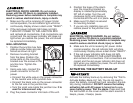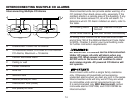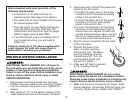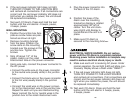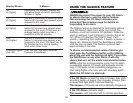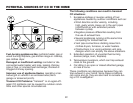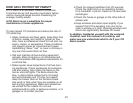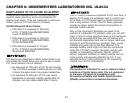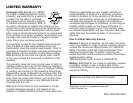
24
CHAPTER 6: UNDERWRITERS LABORATORIES INC. UL2034
WHAT LEVELS OF CO CAUSE AN ALARM?
Underwriters Laboratories Inc. UL2034 defines 3
specific alarm points by which all residential CO
Alarms must alarm. They are measured in parts per
million (ppm) of CO over time (in minutes).
UL2034 Required Alarm Points:
• If the Alarm is exposed to 400 ppm
of CO, IT MUST ALARM BETWEEN
4 and 15 MINUTES
• If the Alarm is exposed to 150 ppm
of CO, IT MUST ALARM BETWEEN
10 and 50 MINUTES.
• If the Alarm is exposed to 70 ppm
of CO, IT MUST ALARM BETWEEN
60 and 240 MINUTES.
CO Alarms are designed to alarm before there is an
immediate life threat. Since you cannot see or smell
CO, never assume it’s not present.
• An exposure to 100 ppm of CO for 20 minutes
may not affect average, healthy adults, but after
4 hours the same level may cause headaches.
• An exposure to 400 ppm of CO may cause
headaches in average, healthy adults after 35
minutes, but can cause death after 2 hours.
This CO Alarm measures exposure to CO over time. It
alarms if CO levels are extremely high in a short peri-
od of time, or if CO levels reach a certain minimum
over a long period of time. The CO Alarm generally
sounds an alarm before the onset of symptoms in
average, healthy adults.
Why is this important? Because you need to be
warned of a potential CO problem while you can still
react in time. In many reported cases of CO exposure,
victims may be aware that they are not feeling well,
but become disoriented and can no longer react well
enough to exit the building or get help. Also, young
children and pets may be the first affected. The
average healthy adult might not feel any symptoms
when the CO Alarm sounds. However, people with
cardiac or respiratory problems, infants, unborn
babies, pregnant mothers, or elderly people can be
more quickly and severely affected by CO. If you
experience even mild symptoms of CO poisoning,
consult your doctor immediately!
This product is intended for use in ordinary indoor
locations of family living units. It is not designed
to measure CO levels in compliance with
Occupational Safety and Health Administration
(OSHA) commercial or industrial standards.



